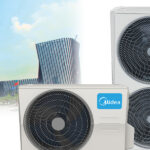With human induced climate change and weather extremes forecast to increase in the short-term future, the need for efficient and eco-friendly air conditioning systems to keep households comfortable is increasing. This may be especially true for countries already being exposed to increasingly frequent extreme weather events, like here in Australia
It is crucial to have sustainable solutions at hand when it comes to the air conditioning systems we have available to keep our homes and places of work comfortable.
In this blog, we explore what it means to choose eco-friendly cooling and heating solutions, and we identify the benefits of R-32 as a refrigerant.
The impact of air-conditioning
Many chemical fluids that make cooling in air conditioning systems possible are also the ones that contribute to heating up our planet. The term ‘greenhouse gases’ is by now a commonly recognisable term, and hydrofluorocarbons (HFC’s), are synthetic greenhouse gases primarily used in refrigeration and air conditioning systems.
So it’s worth thinking about an eco-friendly air conditioning system that uses a refrigerant with a better ecological footprint.
Not all refrigerants are equal
Today, we use the measurement of Global Warming Potentials (GWP’s) to compare the impact of different greenhouse gases on the environment. GWP measures how much energy one tonne of gas will absorb in comparison to one tonne of carbon dioxide. The most common refrigerants are R-410A, R-22, R-134c, and R-32. As you can see from the table below, some of the most commonly used refrigerants today have the worst GWP ratings.
| Refrigerant2 | GWP Rating1 |
| R-410A | 2088 |
| R-22 | 1810 |
| R-134c | 1430 |
We use the eco-friendly refrigerant R-32 in all our Midea heating and cooling systems for good reason.
The benefits of the refrigerant R-32
A high-performance refrigerant with lower environmental impact
The refrigerant R-32 presents a solution with a low comparative environmental impact. Compared to other conventional coolants R-32 has a significantly lower GWP. It can provide an effective reduction of GWP of up to 75%3.
The reason for this also lies in its great efficiency. R-32 can be up to 12% more efficient than R-410A.4 R-32 can can transport thermal energy much more effectively and systems therefore require smaller charge sizes (how much refrigerant is needed per tonne of cooling capacity) of coolant. In fact, systems designed to use R-32 can be engineered to use 40% less charge than a similar R-410A system, meaning less refrigerant being needed, and possibly a reduction in greenhouse gas emission.4
As a result, R-32 achieves one of the best performances in both cooling and heating mode with a very low ecological footprint in comparison to the most common refrigerants on the market.
A more economical solution
Air conditioning systems that use R-32 as a refrigerant tend to require less energy to operate, leading to reduced energy consumption, which means a cheaper cost to run. This is especially prudent given the seemingly ever-increasing costs of energy. It matters to your back pocket.
A safe option
R-32 refrigerant is also a safe option. Though you may read that R-32 is a flammable substance, it requires a lot of energy to ignite it. It is classified as a mildly flammable gas. This means it’s non-explosive and very difficult to ignite and is therefore safe to be used in most air conditioning and heat pump applications. Usually, every household contains appliances with much more flammable substances like propane. However, unlike propane, R-32 cannot be ignited by static electricity, and generally requires around 100 times more energy to ignite.
Another reason that Midea air conditioners use the R-32 refrigerant in our ac systems is its make-up. The R-32 is a single-component refrigerant, pure and not blended with other components. This makes it easier to reuse and recycle the refrigerant. By recovering and recycling refrigerants from extended systems we can make sure less emissions are being released into the atmosphere. Since it also doesn’t change its composition over the course of time, service technicians can safely top up refrigerant in your system – if needed. This additionally saves the process of changing or disposing of refrigerant.
A step forward in environmentally friendly HVAC solutions
Worldwide, over 40 million new appliances using R-32 refrigerant are being installed in homes each year.4
In the quest for sustainable solutions, R-32 refrigerant emerges as a frontrunner in the transition toward environmentally friendly HVAC technologies. Its low GWP, energy efficiency, and ease of recycling make it a compelling choice for businesses and personal homes alike. As we continue to address the challenges of climate change, embracing R-32 represents a meaningful step toward a more sustainable and eco-conscious future. Efficiency, contemporary sustainability, and a dedication to eco-friendly comfort all year round, makes Midea air conditioners a great choice for making yourself at home.






